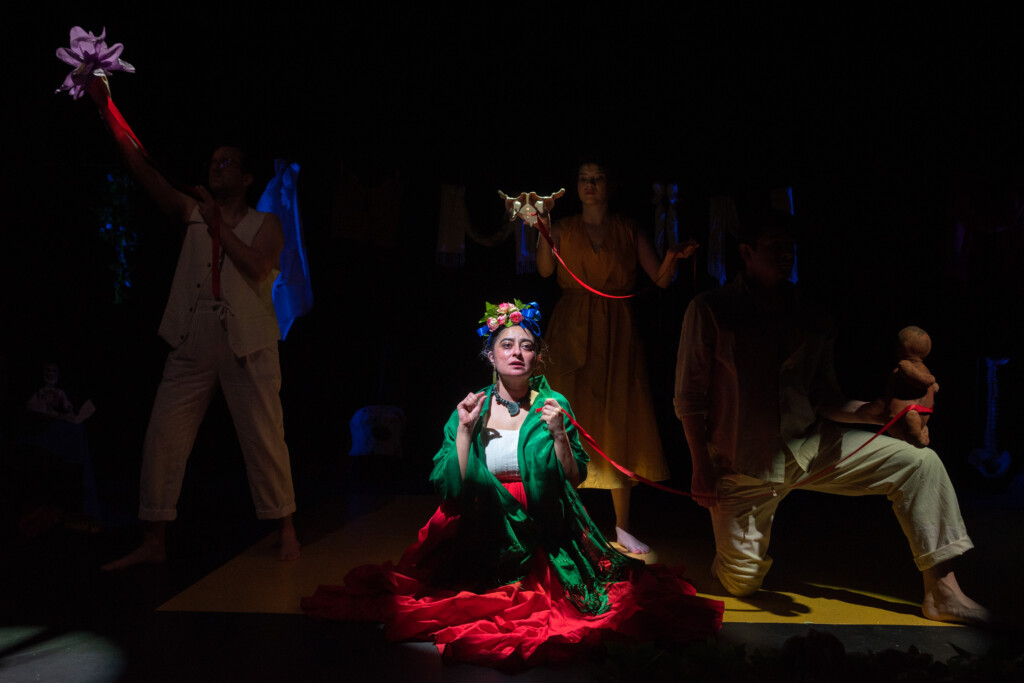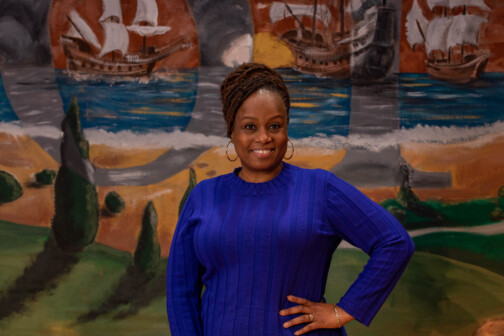A stunning double portrait of and by the Mexican artist Frida Kahlo hangs in the Museo de Arte Contemporaneo in Mexico City. In the painting The Two Fridas (1939), the artist quite literally wears her heart on her clothing. The two versions of her clasp hands and are connected by veins that hold her pomegranate-red blood. At the Latino Cultural Center, Cara Mía Theatre offers another double portrait of Frida Kahlo, who has now become an icon across the globe.
The play To DIE:GO in Leaves by Frida Kahlo is a bold tour de force that renders the emotional tenor of her life with gorgeous clarity. You have until March 12 to see it.
The unusual, immersive piece is essentially a remounting of a production that premiered 20 years ago, written and performed by a portion of the same cast. This time, however, a full Spanish translation has been added and a bilingual cast delivers performances in English and Spanish on alternate nights. In that sense, it is a first for the company and for Dallas, one that underscores the relevance and rich duality for which Cara Mía aims.
Nuanced and whimsical in its staging, the production remains fiercely and defiantly joyful, even as it delves into the physical pain that the artist endured throughout her life after a trolley car collided with a bus in which she was riding when she was 18 years old. The incident left her with a punctured abdomen and fractures in much of her body. A litany of surgeries—a medical history delivered by year—interrupts the dialogue, but it’s Kahlo’s internal world that animates the stage.
Puppets come to life, a bed is made of actors, and flashbacks and dream sequences proliferate, while original music performed by Kweku Codrington creates a percussive, responsive backdrop. In this production, the narrative teeters between reality, imagination, and metaphysics.
This rich world of Kahlo came to be 20 years ago.
“I became artistic director in 2002, and it was one of the first productions I produced,” says David Lozano, who was a student at the University of Texas at Dallas. “I knew what I wanted to do, which was create and produce new plays and especially created by the actors. I wanted to focus on ensemble creation.”
Meanwhile, Maryam Obaidullah Baig, also at UTD, had been encouraged by her senior honors thesis advisor to write a play about Kahlo as her final project.
“I was a visual art student and he was my drawing and sculpture professor,” she says, but she had done extensive theater work, and “my professors really liked the way I appeared on stage. They insisted. Drawing was my focus. [But they] believed that my visual art side could be expressed through Frida’s artistic life.”
And so it began.
“We got together and started writing about her paintings, creating material,” Lozano says.
They enlisted Justin Brumit, Julian Guevara, and Alana Libertad Macias as writers and actors, creating collages of material, a mix of free association and improvisation that coalesced into a play.
The group rehearsed in spaces such as the now-defunct Ice House Cultural Center in Oak Cliff in the sweltering summer of 2003 on a shoestring budget. They had trouble retaining actors, initially, for the movement-heavy piece.
“In her paintings we had something we could hold,” says director and longtime mentor Jeffry Farrell, who helped the students build physical imagery that would allow the audience to follow the story.
“If you get into the nature common to all cultures,” Farrell says of theater through the ages, it’s “the live actor and physical presence and breath. It is not a screen. That’s the very nature of the work for me: the physical embodiment and qualities of presence.”
It is a matter of conveying imagery through the body, “conveying qualities of experience that the audience can assign meaning to.”
Cara Mía does this beautifully, evocatively, such that the images linger with you long after you leave.
There was not even a complete script from the 2003 run at the White Rock Lake Bath House Cultural Center, as it had been changing every day, including the day before the opening. And so when Lozano decided to remount the play, he believed it could still evolve. Why not go farther, with a full added translation—and a cast that could take it on?
The theater has significantly larger audience base, which Lozano estimates has grown more than 10 to 15 times its initial size. “Over the past few years, we’ve been producing more pieces in Spanish, usually with supertitles.” And he had heard of companies in which the same ensemble of actors performed an English and Spanish production in repertory.
“We have a great community of bilingual actors” in Dallas, Lozano says. So they cast the play with actors who could perform in both series of nights.
The only role that alternates is the central role of Frida Kahlo. Frida Espinosa Müller, who was born in Mexico, translated the play and imagined the world of props and plaster corsets for Kahlo and performs the role in the Spanish productions.
She and Baig took different approaches to developing their Fridas.
For Baig, it was about letting the character emerge from her own letters and diaries. “I believe that once biographers get involved, there is a sense of comment,” she says. “I just wanted Frida and her words and her images and her medical history.”
Her own work identifying with the character began as a diary and chronology, inserting her own life-changing events into Kahlo’s timeline.
Müller’s challenge in the Spanish translation, which she wrote in less than three weeks, was rendering the voice of a writer who wrote with shocking lyricism. In one letter shortly after the bus accident, Kahlo describes living in “a painful planet, transparent as ice.”
Returning to the original fragments of diary entries and letters, Müller comments on Kahlo’s “automatic,” stream-of-consciousness writing that allows one to see the mental and emotional processes occurring.
In addition, “it is a very Mexican translation,” Müller says. “She uses words that no other Spanish-speaking culture would use. Being Mexican allowed me to understand Frida’s way of talking” and to emphasize the cultural specificity.
“Frida Kahlo is almost defiantly Mexican,” Lozano says. The original ensemble did not have any actors born in Mexico. Now it does.
But the takeaway is universal.
“We aim to find Frida the person. And the character that suffered but also the character that sought life: where she found life. Where she found love. That’s what sustained her through this,” Farrell says.
The Cara Mía ensemble’s aim is ever “to tell our stories that are important to our community,” as Lozano points out.
But “in her pain there is safety, where we find ourselves not alone. So that is a gift,” Baig says of the much-represented female artist whose likeness now finds wildly large representation in virtual reality shows. What if we were to start over and return to her? That is part of the overwhelming intimacy and poignancy the production creates.
Ultimately, “I’m a smarter actor,” Lozano admits. “I understand the nuances of the things that we created. Because we created so much so quickly [20 years ago] that when we performed it, we just burst with the energy of an ensemble of 20-year-olds. Here we are able to bring more of our craft.”
“This kind of work aims to heighten human presence and recognize our essentially human nature and the conditions of our human nature,” Farrell says.
It’s a brief performance—just over an hour—but it is uniquely powerful.
Correction: A previous version of this story identified Jeffry Farrell as a UT Dallas faculty member. That was incorrect.
Get the FrontRow Newsletter
Author






